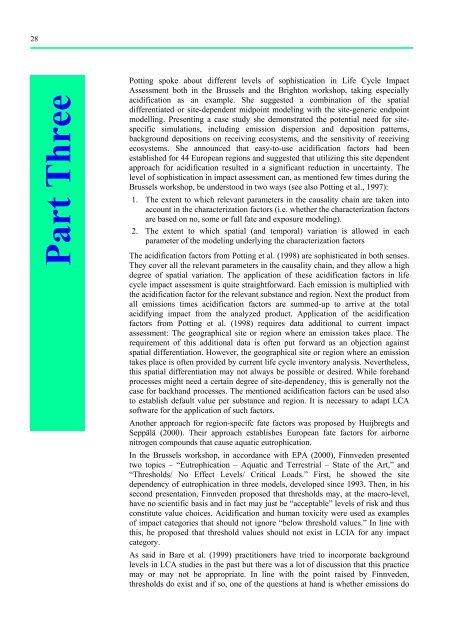Evaluation of Environmental Impacts in Life Cycle Assessment - estis
Evaluation of Environmental Impacts in Life Cycle Assessment - estis
Evaluation of Environmental Impacts in Life Cycle Assessment - estis
Create successful ePaper yourself
Turn your PDF publications into a flip-book with our unique Google optimized e-Paper software.
28<br />
Part Three<br />
Pott<strong>in</strong>g spoke about different levels <strong>of</strong> sophistication <strong>in</strong> <strong>Life</strong> <strong>Cycle</strong> Impact<br />
<strong>Assessment</strong> both <strong>in</strong> the Brussels and the Brighton workshop, tak<strong>in</strong>g especially<br />
acidification as an example. She suggested a comb<strong>in</strong>ation <strong>of</strong> the spatial<br />
differentiated or site-dependent midpo<strong>in</strong>t model<strong>in</strong>g with the site-generic endpo<strong>in</strong>t<br />
modell<strong>in</strong>g. Present<strong>in</strong>g a case study she demonstrated the potential need for sitespecific<br />
simulations, <strong>in</strong>clud<strong>in</strong>g emission dispersion and deposition patterns,<br />
background depositions on receiv<strong>in</strong>g ecosystems, and the sensitivity <strong>of</strong> receiv<strong>in</strong>g<br />
ecosystems. She announced that easy-to-use acidification factors had been<br />
established for 44 European regions and suggested that utiliz<strong>in</strong>g this site dependent<br />
approach for acidification resulted <strong>in</strong> a significant reduction <strong>in</strong> uncerta<strong>in</strong>ty. The<br />
level <strong>of</strong> sophistication <strong>in</strong> impact assessment can, as mentioned few times dur<strong>in</strong>g the<br />
Brussels workshop, be understood <strong>in</strong> two ways (see also Pott<strong>in</strong>g et al., 1997):<br />
1. The extent to which relevant parameters <strong>in</strong> the causality cha<strong>in</strong> are taken <strong>in</strong>to<br />
account <strong>in</strong> the characterization factors (i.e. whether the characterization factors<br />
are based on no, some or full fate and exposure model<strong>in</strong>g).<br />
2. The extent to which spatial (and temporal) variation is allowed <strong>in</strong> each<br />
parameter <strong>of</strong> the model<strong>in</strong>g underly<strong>in</strong>g the characterization factors<br />
The acidification factors from Pott<strong>in</strong>g et al. (1998) are sophisticated <strong>in</strong> both senses.<br />
They cover all the relevant parameters <strong>in</strong> the causality cha<strong>in</strong>, and they allow a high<br />
degree <strong>of</strong> spatial variation. The application <strong>of</strong> these acidification factors <strong>in</strong> life<br />
cycle impact assessment is quite straightforward. Each emission is multiplied with<br />
the acidification factor for the relevant substance and region. Next the product from<br />
all emissions times acidification factors are summed-up to arrive at the total<br />
acidify<strong>in</strong>g impact from the analyzed product. Application <strong>of</strong> the acidification<br />
factors from Pott<strong>in</strong>g et al. (1998) requires data additional to current impact<br />
assessment: The geographical site or region where an emission takes place. The<br />
requirement <strong>of</strong> this additional data is <strong>of</strong>ten put forward as an objection aga<strong>in</strong>st<br />
spatial differentiation. However, the geographical site or region where an emission<br />
takes place is <strong>of</strong>ten provided by current life cycle <strong>in</strong>ventory analysis. Nevertheless,<br />
this spatial differentiation may not always be possible or desired. While forehand<br />
processes might need a certa<strong>in</strong> degree <strong>of</strong> site-dependency, this is generally not the<br />
case for backhand processes. The mentioned acidification factors can be used also<br />
to establish default value per substance and region. It is necessary to adapt LCA<br />
s<strong>of</strong>tware for the application <strong>of</strong> such factors.<br />
Another approach for region-specifc fate factors was proposed by Huijbregts and<br />
Seppälä (2000). Their approach establishes European fate factors for airborne<br />
nitrogen compounds that cause aquatic eutrophication.<br />
In the Brussels workshop, <strong>in</strong> accordance with EPA (2000), F<strong>in</strong>nveden presented<br />
two topics – “Eutrophication – Aquatic and Terrestrial – State <strong>of</strong> the Art,” and<br />
“Thresholds/ No Effect Levels/ Critical Loads.” First, he showed the site<br />
dependency <strong>of</strong> eutrophication <strong>in</strong> three models, developed s<strong>in</strong>ce 1993. Then, <strong>in</strong> his<br />
second presentation, F<strong>in</strong>nveden proposed that thresholds may, at the macro-level,<br />
have no scientific basis and <strong>in</strong> fact may just be “acceptable” levels <strong>of</strong> risk and thus<br />
constitute value choices. Acidification and human toxicity were used as examples<br />
<strong>of</strong> impact categories that should not ignore “below threshold values.” In l<strong>in</strong>e with<br />
this, he proposed that threshold values should not exist <strong>in</strong> LCIA for any impact<br />
category.<br />
As said <strong>in</strong> Bare et al. (1999) practitioners have tried to <strong>in</strong>corporate background<br />
levels <strong>in</strong> LCA studies <strong>in</strong> the past but there was a lot <strong>of</strong> discussion that this practice<br />
may or may not be appropriate. In l<strong>in</strong>e with the po<strong>in</strong>t raised by F<strong>in</strong>nveden,<br />
thresholds do exist and if so, one <strong>of</strong> the questions at hand is whether emissions do
















